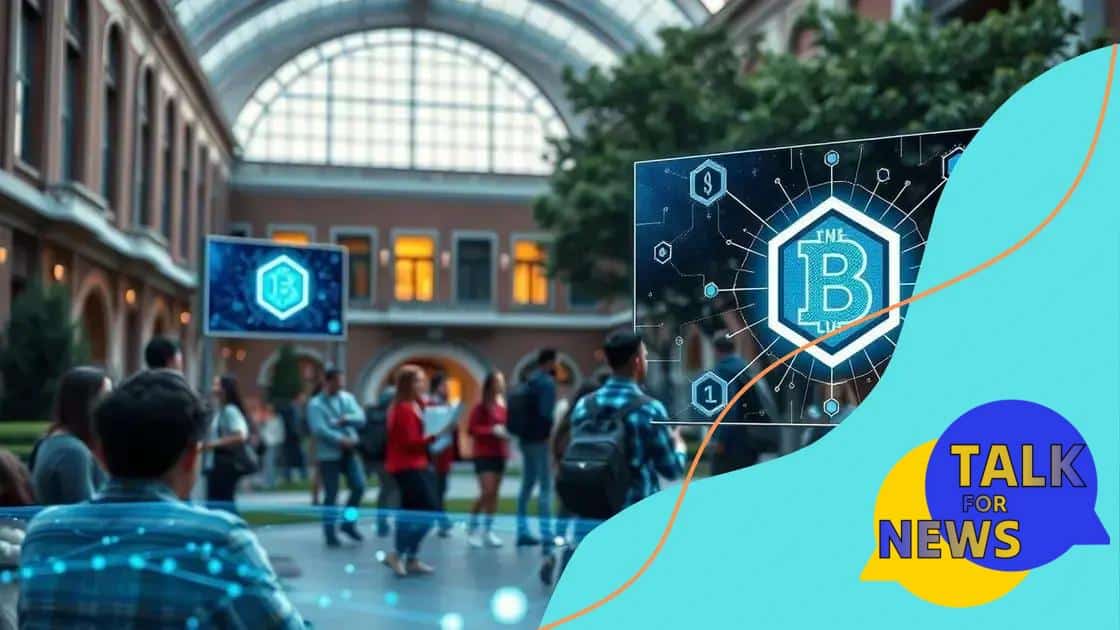How blockchain is changing the way academic credentials are verified

Anúncios
Blockchain is changing the way academic credentials are verified by providing a secure, decentralized, and tamper-proof system that enhances trust and efficiency in the verification process.
How blockchain is changing the way academic credentials are verified opens a fascinating discussion about trust and transparency in education. Ever thought about how this technology could validate your degree?
Anúncios
Understanding blockchain technology
Understanding blockchain technology is essential as it underpins the changes in how we verify academic credentials. At its core, blockchain is a decentralized digital ledger that records transactions across multiple computers securely and transparently. This means that no single entity controls the data, making it trustworthy and tamper-proof.
This technology operates in a unique way. Each transaction is grouped into a block, and once a block is filled, it is chained to the previous one, creating a secure record that is visible to all participants in the network.
Key Characteristics of Blockchain
Anúncios
Some key characteristics of blockchain include:
- Decentralization: Unlike traditional databases, there is no central authority.
- Transparency: Every participant can see the entire chain, ensuring accountability.
- Immutability: Once a block is added, altering it is nearly impossible.
These features help instill trust among users, especially when it comes to verifying credentials. Educational institutions can store student records on a blockchain, allowing employers to easily verify degrees and qualifications without relying on bureaucratic processes.
The Importance of Security
Security is paramount in credential verification. By leveraging blockchain technology, institutions can reduce the risk of diploma fraud. Each credential can be securely linked to a verified public key, enabling secure access for employers and reducing the need for extensive background checks.
Moreover, the enhanced security measures help protect sensitive data, ensuring that student information remains protected from breaches. This innovation could catalyze a change in how both educational institutions and employers interact, potentially reshaping the landscape of job recruitment.
In conclusion, as we explore the potential of blockchain in academic credential verification, it becomes clear that this technology not only enhances security but also streamlines the verification process. Its unique characteristics make it a powerful tool for modern education.
The role of blockchain in credential verification
The role of blockchain in credential verification cannot be overstated. It offers a fresh perspective on how we authenticate educational achievements. With traditional methods, verifying a degree can take time and may involve contacting different institutions. However, blockchain streamlines this process significantly.
When institutions adopt blockchain technology, they create a digital record for each credential. This record is tamper-proof and accessible to employers seeking to verify a candidate’s qualifications. Such a system minimizes the chances of fraud.
Benefits of Using Blockchain
There are several key benefits to using blockchain for verifying credentials:
- Efficiency: Verification is quicker since records are stored in a decentralized system.
- Security: Data is protected against unauthorized changes, keeping credentials safe.
- Cost-Effective: Reduces the expenses associated with paper-based verification processes.
These advantages illustrate why many educational institutions are eager to embrace this technology. Not only does it simplify the verification process, but it also enhances trust between educational facilities and employers.
Furthermore, blockchain allows for real-time access to verified credentials. Employers can instantly check if a candidate’s qualifications are genuine without lengthy waiting periods. This immediate access builds a stronger connection between educational accomplishments and job opportunities.
Another important aspect is the ability to track achievements over time. Students can hold onto a secure digital record of their credentials, which they can share whenever necessary. This empowers them in their job searches and career advancements.
Benefits for educational institutions

The benefits for educational institutions adopting blockchain technology are substantial. By moving the verification of academic credentials to a blockchain system, colleges and universities can simplify many processes. This technology provides transparency and efficiency that traditional methods lack.
Firstly, using blockchain helps to enhance the trustworthiness of academic records. Institutions can ensure that the credentials they issue are secure and verifiable. This builds a reliable image of the institution in the eyes of employers and students.
Efficiency in Record Keeping
One of the main advantages is the efficiency gained in record keeping. By having all student records on a blockchain, schools can:
- Reduce administrative costs: Streamlined processes lower the need for extensive human resources.
- Speed up verification: Access to real-time data allows for immediate checks of students’ qualifications.
- Minimize errors: Automated systems decrease the likelihood of human mistake when processing records.
These improvements lead to faster admissions and graduation processes, benefitting both students and institutions. Moreover, a secure electronic record keeps sensitive data safe and ensures compliance with regulations.
Blockchain also opens new opportunities for institutions to create transparent partnerships with businesses. Employers can trust the data provided by schools, which aids in recruitment efforts. By having a digital, verifiable history of students’ achievements, businesses can make better hiring decisions.
Additionally, the use of blockchain technology can be a value addition to an institution’s reputation. Schools that embrace modern technological solutions are seen as innovative and forward-thinking, which can attract more students and funding opportunities.
Challenges in adopting blockchain for credentials
Adopting blockchain technology for credential verification presents several challenges that educational institutions must navigate. While the benefits are clear, understanding these obstacles is crucial for effective implementation.
One major challenge is the initial cost of integrating blockchain systems. Setting up a blockchain infrastructure requires significant investment in technology and training.
Technical Complexity
The technical complexity involved in adopting this technology can also be daunting. Institutions need to ensure they have the expertise to implement and maintain a secure blockchain system. Without proper knowledge, there is an increased risk of errors or vulnerabilities in data security.
Moreover, resistance to change plays a significant role. Many educators and administrators may feel uncomfortable transitioning from traditional systems to a digital format. This hesitance can slow down the adoption process, even when the advantages are evident.
- Data Privacy Concerns: Students may worry about how their personal information will be used or shared across the blockchain.
- Interoperability Issues: Different blockchains may not communicate well with one another, causing fragmentation.
- Regulatory Compliance: Institutions must navigate laws and regulations surrounding data storage and sharing.
Additionally, there can be concerns about data ownership and control. Institutions must define who owns the records stored on the blockchain and how access is granted. These discussions require legal insight and stakeholder involvement to ensure everyone’s rights are protected.
Finally, the rapid pace of technological change can leave institutions struggling to keep up. As new advancements arise, educational organizations need to remain flexible and ready to adapt, which can be a daunting task.
Future trends in academic verification
The future trends in academic verification are leaning heavily towards the integration of advanced technologies like blockchain. As educational institutions continue to adapt, several exciting possibilities are emerging.
First, we can expect wider adoption of decentralized platforms. These platforms will allow students to easily share their verified credentials with employers, reducing the administrative burden on both parties.
Enhanced Data Security
Another trend is the increase in data security. Blockchain technology provides a secure method for storing sensitive student information. This leads to lower risks of identity theft and credential fraud, ensuring that the verification process remains safe and reliable.
In addition, institutions are likely to begin using smart contracts, which automate various processes. For example, once certain conditions are met, a student’s credentials can be automatically verified and shared with potential employers.
- Integration with AI: The combination of AI and blockchain can improve the verification process by quickly validating degrees and other credentials.
- Global Standards: We may see the development of global verification standards, making it easier to manage academic records across borders.
- Increased Transparency: Future systems will provide more transparency in how credentials are verified and shared, building trust among stakeholders.
As these trends develop, educational institutions will also need to focus on collaboration. Partnerships between schools, employers, and tech companies will become essential. Together, they will create a seamless experience for credentialing.
Moreover, with the rise of online education, the need for robust verification systems is more crucial than ever. As more students earn degrees from various online platforms, having a reliable method of credential verification will help employers distinguish between genuine and fraudulent claims.
Conclusion:
In conclusion, blockchain technology is transforming the way academic credentials are verified. It offers many benefits such as increased security, efficiency, and trust. While there are challenges to overcome, the future looks bright with advancements in this area. By embracing these changes, educational institutions can provide better services for students and employers alike. As they adapt to these new technologies, the landscape of academic verification will continue to evolve, making it easier and safer for everyone involved.
FAQ – Frequently Asked Questions about Blockchain in Academic Credential Verification
What is blockchain technology?
Blockchain is a decentralized digital ledger that securely records transactions across multiple computers, ensuring transparency and security.
How does blockchain improve credential verification?
It enhances trust by providing a tamper-proof record of academic credentials that can be easily verified by employers.
What are the main challenges of adopting blockchain in education?
Challenges include high initial costs, technical complexity, and resistance to changing traditional processes.
What future trends should we expect in academic verification?
Expect increased use of AI, smart contracts, and the development of global standards for credential verification.





